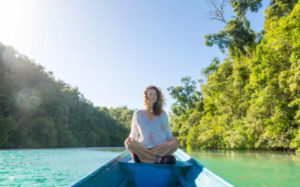What is the Geography of the Raja Ampat area?
Learn more
Raja Ampat can be classified into three sectors, the North, Central and South.
Biodiversity Nature Resort is situated on Gam Island, which is in CENTRAL Raja Ampat, in the area known as the Dampier Strait.
It was named and discovered by Captain Sir William Dampier, who according to some sources “was an English explorer, ex-pirate and navigator who became the first Englishman to explore parts of what is today Australia, and the first person to circumnavigate the world three times”. The strait is named after the first European to sail through it in 1700 in HMS Roebuck.
Wayag to Uraine – Wayag Island is known for its beautiful atolls and amazing underwater life covering a total area of 155,000 hectares, about 383,013.3 acres. Here, you find pristine beaches with unique Karst islands that look like mushrooms sprouting out from the sea. You will pass Quoy and Bag Island before reaching Uranie Island. Uranie is named in honor of a French frigate that circumnavigated the globe; the remote, rough and wild beauty of Uranie rarely sees many visitors. It is a sheltered bay with amazing reefs and numerous caves along the north coast, home to a large population of grey reef sharks. It has dramatic landscape and hidden lake.
Kawe – It has a coral network threaded among a myriad of tiny isles. It is an uninhabited island with an adventurous geographical position.
CENTRAL RAJA AMPAT
West Waigeo –consists of many villages, ancient cultural sites and of course beautiful waters and landscapes. You can find the Aljui Bay (the pearl farms are here), Pulau Manyaifun Island with many hills and one single village, Moes Manggara Islands which are low, flat sand clay stretches with only three being inhabitable and Yef Kabu Island, a long white beach enclosed by coconut palms.
Batanta Island – it is the smallest of the four main islands but it is over 60km in length. It is densely forested with long central hills. It is more remote and the villages are less developed. Its big draw point, along with its historical dive sites, is the waterfalls and Wilson bird of paradise.
Fam Islands (Penemu Island) – a group of islands with some top dive sites and an iconic viewpoint that almost every tourist that travels here visits. On land and under the water they are beautiful!
Dampier Strait – The Dampier Strait is situated in the Indonesian province of West Papua and is a strait that separates the Raja Ampat islands of Mansuar and Gam and Batanta in the southern region. It also passes by the islands of Kri, Koh and Arborek.
Kofiau – It is the smaller and least visited among the major islands. The island is comprised primarily of raised coral limestone and some volcanic hills covered in rainforest. It has a popular inland lake to visit.
Misool – It is one of the main islands in Raja Ampat with world-renowned dive sites. Crystal clear waters, heavily forested landscapes and mangrove forests. White sands beaches with coconut palms and home to ancient cultural sites.
The dive sites in Dampier Strait are famous because of their currents and the diving techniques needed to dive the site (such as the use of reef-hooks). It is important to note this if you are diving in the Strait of Dampier; take into consideration your level and realize that there may be some places where you should not dive. Being an advanced diver will benefit you. But it also has calms clear waters creating some amazing locations to go snorkelling. In the water, some fishes live peacefully and many corals are scattered. These objects become the prime attractions for divers. Not to mention the temperature is lukewarm and the current is small. What an amazing nautical landscape!
YOU MAY ALSO LIKE

FISH BIOMASS
Raja Ampat’s isolation and sparse human population have played a major role in keeping its reefs healthy, which overall have contributed to the biomass of fish you will discover on each dive or snorkel with us at Biodiversity.

The Top List of Species and Endemic Species
Your aquatic adventure must include the species that every visitor lists as the best, including, endemic species that can only be found in Raja Ampat, which continue to be added to the ever-new discoveries of more species

























